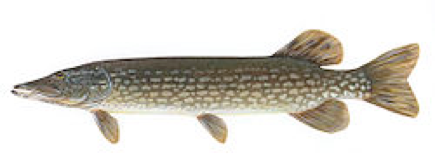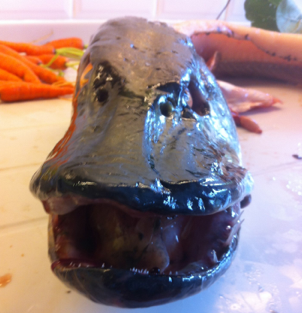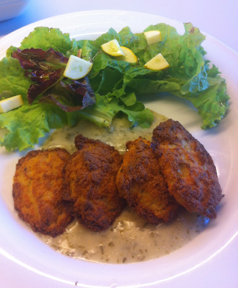 Today’s blog is not about bridge, it is about fish.
Today’s blog is not about bridge, it is about fish.
Seriously, it is about fish, or rather how to prepare 10kg of pike.
What, why you may wonder? OK, there is a vague link to the game. Most bridge players are familiar with a story by Roald Dahl called “My lady love, my dove” in which a young married couple finds an interesting way to cheat. Obviously Roald didn’t play bridge, since if he did, he’d known that the number of card combinations is much larger than the code. While Dahl is known for his stories, he and his wife organized and attended many dinner parties, and he once wrote up the recipes in two books. That is about as much of a bridge link as you’ll get in this blog.
Last Saturday, the wife and I were doing our weekly shopping. That always includes a stop at Heinen en Koelewijn for fish. Heinen en Koelewijn were recently named the best fish mongers in the country and their products are indeed really good. Sometimes they have a special for the regular customers. As we have buying fish there for at least 10 years, we are in that group. On display in the shop was a fish of about a meter long. A pike, the owner told us.
 Now pike is an interesting fish. Only amateurs are allowed to catch them in this country and then, when they catch one, they have to put it back. Which must be interesting, the hook has to be removed from the mouth of the fish. And that mouth is full with needle sharp, 1cm long teeth and part of a fish that is obviously not amused with being caught. Commercial fisherman are not allow to fish pike, if they catch one in the process of catching something else, they have to put it back. Only if they feel that it has been hurt too much and won’t survive anyway, they can sell it. Add this all up and you’ll understand why you almost never see one in a shop. And because it is so rare, people don’t know how to prepare it.
Now pike is an interesting fish. Only amateurs are allowed to catch them in this country and then, when they catch one, they have to put it back. Which must be interesting, the hook has to be removed from the mouth of the fish. And that mouth is full with needle sharp, 1cm long teeth and part of a fish that is obviously not amused with being caught. Commercial fisherman are not allow to fish pike, if they catch one in the process of catching something else, they have to put it back. Only if they feel that it has been hurt too much and won’t survive anyway, they can sell it. Add this all up and you’ll understand why you almost never see one in a shop. And because it is so rare, people don’t know how to prepare it.
But Geert had read Roald’s book and remembered one of the more unusual recipe’s in there. Pike dumplings, or pike quenelles. Very nice according to Roald but almost never seen on a menu in a restaurant as pike is rare and, while it isn’t hard, takes a lot of effort to prepare. To cut a long story short, we ended up with some 5 kg of pike filet for a very nice price.
On Sunday, Geert tried to prepare them. The taste was good, but the structure horrible, the sauce way to heavy and it didn’t look at all like the picture in the book. Sorry, I can’t show a copy of that, as it is copyrighted. It gave me a head start on Monday, when I tried to do version 2. Here is how we did that. In white the original recipe, in yellow our comments and improvements.
- Put 55 gr of butter and 3 dl of water in a pan and let it melt. Add 115 gr of flower and stir until smooth. Boil for a few minutes until doesn’t stick to the pan. Add 2 eggs and let it cool down.
- Put 450 gr of fish in a blender and chop really fine. Add salt and peper and about 1.5 dl of cream. Be generous with the salt and pepper. Push through a sieve. Note: I’m not sure why this is necessary, if you carefully removed all the bones from the fish, the mixture looked smooth enough to me. Add the butter/flower/egg mixture and let this cool down for a couple of hours.
- Take a big pan of water and bring it to the boil. Roll balls the size of a ping-pong ball from the fish mixture. Put the balls in the pan for about 15 to 20 minutes, until they feel solid. Don’t put too many balls in the pan, they should have room to move. Take them out of the water and put them on a tray covered with baking paper. Again, give them some room, they tend to flatten a bit and they should not touch each other. Guess what we did wrong in version 1.0? Too many balls in the pan, ending up with a solid layer of boiled fish dough. Cutting it into pieces fixed that but is isn’t as it should be. When done, keep the water for the sauce.
- When done, put the fish balls in an oven of about 150 degrees for an hour. We did that and found they were not fully cooked and very white after that, so we did another 10 minutes at 220 degrees, to give them a nice crust while they were still soft inside.
- In the meantime, make the sauce. First chop up an union, melt a bit of butter in a casserole (a pan with a think bottom) and fry until it starts to soften. Add a glass of white wine and let it cook until most of the liquid is gone. Put it in a bowl. (Roald started with another pan, I don’t quite see why you’d toss the flavor away). Melt 25 gr of butter and add 25 gr of flower (Roald used 45 of both, but that gave way too much sauce), then add a little milk and stir until smooth. Let it boil for a few minutes, then add a couple of cups of the water from the fish and heat again. Add about 30 gr of grated Parmesan cheese (Roald used 100 on about twice as much sauce, but that made the sauce too heavy), the onion with the remnants of the wine, pepper to taste. I didn’t think the sauce was fresh enough, so I added the juice of half a lemon and some freshly chopped herbs from the garden. Roald also added cream, I left it out as the sauce was rich enough already.
- To serve, we did the opposite of Roald: put a spoonful of sauce on a plate, then the fish dumplings on top of them. They will stay crispy much longer. Serve with a bit of salad and boiled potatoes. Roald puts the sauce on top of them, making them soggy after a few seconds.
Enjoy!

The kids loved our 2.0 version, so did the guest we had for dinner. Geert and I think that the fish should have been seasoned a bit stronger, perhaps adding a sliced pepper or so. That will go into version 3.0. I’d also serve it as a starter, rather than a main, leaving out the salad and potatoes.
I’m playing tonight, so expect something about bridge later this week.
